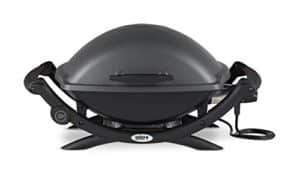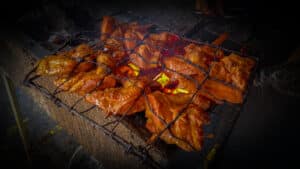How To Control Temperature On A Charcoal Grill?
Key Takeaways
- Adjusting the air dampers is a fundamental way to control temperature on a charcoal grill
- Investing in a reliable thermometer is essential for accurate temperature control
- Using a water pan can help regulate temperature and add moisture to the cooking environment
Controlling the temperature on a charcoal grill is crucial for achieving the perfect cooking results. Whether you’re grilling steaks, smoking ribs, or slow-cooking brisket, having the ability to regulate the heat allows you to cook your food to perfection. In this article, we will explore various tips and methods for controlling temperature on a charcoal grill, so you can become a master of your grill and impress your friends and family with delicious meals.
Adjusting Air Dampers
One of the fundamental ways to control temperature on a charcoal grill is by adjusting the air dampers. The basic principle is that more air leads to a hotter fire, while less air cools it down. To achieve this:
- Leave the bottom dampers fully open to allow maximum airflow.
- Use the top lid damper to control the temperature.
By manipulating the top lid damper, you can fine-tune the temperature to your desired level. Here are some suggested top lid damper settings for different temperatures:
- High heat (450-550°F) – Fully open
- Medium heat (350-450°F) – ½ open
- Low heat (250-350°F) – ¼ open
- Low and slow/smoke zone (225-275°F) – 1/4 – 1/8 open
- Off – Fully closed
These settings serve as a starting point, and you may need to make adjustments based on your specific grill and cooking conditions.
Investing in a Reliable Thermometer
To ensure accurate temperature control, it is essential to have a reliable thermometer to monitor the temperature inside the grill. A thermometer allows you to gauge the heat and make necessary adjustments. There are various types of thermometers available, including digital and analog options. Choose one that suits your preferences and budget.
Using a Water Pan
Adding a water pan to your charcoal grill can help regulate temperature and add moisture to the cooking environment. The water pan acts as a heat sink, absorbing some of the heat and preventing the grill from getting too hot. It also adds moisture to the air, which can help keep your food juicy and prevent drying out.
Foil-Wrapped Bricks
If you’re planning a long smoke, foil-wrapped bricks can be a useful tool for retaining heat. Place the foil-wrapped bricks on the grill grate, and they will absorb and radiate heat, providing a more stable temperature for extended cooking sessions.
Adjusting Vents for Fine-Tuning
Another way to control temperature on a charcoal grill is by adjusting the vents. The intake and exhaust dampers play a crucial role in regulating airflow and, consequently, heat.
By opening the vents, you allow more oxygen into the grill, which increases the heat. Conversely, closing the vents restricts airflow, reducing the temperature. Experiment with adjusting the intake and exhaust dampers to find the right balance for your desired temperature.
The Minion Method and the Log Cabin Method
Two additional methods for controlling temperature on a charcoal grill are the Minion Method and the Log Cabin Method. These methods are particularly useful for low and slow cooking.
The Minion Method involves lighting a smaller amount of coals and gradually lighting up the unlit coals. This method provides a steady and consistent heat source for extended cooking sessions.
The Log Cabin Method involves stacking the charcoal in a log cabin-like structure. This method allows for easy control of the burn rate and temperature, as you can simply remove or add charcoal as needed.
Additional Tips and Considerations
Here are some additional tips and considerations for controlling temperature on a charcoal grill:
- Wait for the temperature to stabilize before making any adjustments. It takes time for the grill to respond to changes in airflow or fuel.
- Monitor the temperature regularly using a thermometer and make adjustments as necessary.
- Consider using a grill shield made of aluminum foil to block heat and slow down the cooking process if needed.
- For indirect cooking, set up a two-zone fire by placing all the coals to one side of the grill. This creates a hot zone for searing and a cooler zone for indirect cooking.
- Experiment and practice with your specific grill to become familiar with its quirks and achieve consistent temperature control.
Conclusion
Controlling temperature on a charcoal grill is a skill that can be mastered with practice and knowledge. By adjusting the air dampers, using a reliable thermometer, utilizing water pans and foil-wrapped bricks, and fine-tuning the vents, you can achieve the desired heat levels for various cooking techniques. The Minion Method and the Log Cabin Method are additional techniques that can be employed for low and slow cooking. Remember to be patient and allow time for the temperature to stabilize before making adjustments. With these tips and methods, you’ll be well on your way to becoming a master of temperature control on your charcoal grill.
Related Websites:
FAQs:
Q: Why is temperature control important on a charcoal grill?
Temperature control is crucial on a charcoal grill to ensure that your food is cooked perfectly. It allows you to achieve the desired level of doneness and prevents overcooking or undercooking. Additionally, proper temperature control helps to enhance flavors and textures, resulting in delicious and juicy grilled dishes.
Q: What are the components that affect temperature control on a charcoal grill?
The components that affect temperature control on a charcoal grill are airflow and oxygen supply, fuel arrangement and quantity, and ventilation and damper settings. These factors play a significant role in regulating the heat and maintaining a consistent temperature throughout the grilling process.
Q: How do I prepare a charcoal grill for optimal temperature control?
To prepare a charcoal grill for optimal temperature control, you should select the right charcoal and arrange it properly. Start the charcoal using methods such as a chimney starter or lighter fluid. Ensure proper ventilation by adjusting the vents and dampers according to the desired temperature.
Q: What techniques can I use for temperature control on a charcoal grill?
For low temperatures, use the low and slow cooking method by adjusting the vent and damper settings for low heat and maintaining a consistent temperature for extended periods. For high temperatures, use the direct grilling method by opening vents and dampers for increased airflow, allowing you to achieve and maintain high heat for searing and quick cooking.
Q: What are some tips and tricks for effective temperature control on a charcoal grill?
To effectively control temperature on a charcoal grill, you can monitor the temperature using methods such as a grill thermometer. Additionally, manage flare-ups and control excessive heat by adjusting the vent and damper settings accordingly. Lastly, remember that mastering temperature control requires patience and practice, so keep experimenting and adapting techniques to suit your specific grilling needs.






